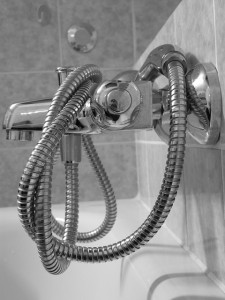Saving water is an important part of economical and environmentally responsible living. However, it can be really easy to waste large quantities without even realizing it! The bathroom is the key contributor to this problem in many households, with showers and tubs quickly consuming gallons of water every day. Here are some tips on getting the most out of your bath or shower, helping the environment, and saving money in the process.
1. Turn it off.
Try not to let the water run if you’re not using it. Turn it off while you lather up or shampoo your hair; then switch it back on when it’s time to rinse. If you dislike cold water, while you wait for it to warm up, collect it in a bucket or similar container. This can be used for other purposes, such as brushing your teeth, soaking dishes, or watering plants.
2. Take shorter showers.
Shower heads can flow at a rate of as much as 5 gallons per minute, so even shaving 2 minutes off your shower each day could save you up to 70 gallons of water per week! If you prefer to take baths, consider filling the tub a little less than you usually do. Even small changes accumulate over time into large savings.
3. Make baths a treat.
Taking a bath can use up to twice as much water as a shower, so if you want to save water, it’s best to stick with the latter option. Of course, that is no reason to cut baths out of your life completely. Simply make the most of them by turning bath time into a luxurious treat. Add some scented oils or bubbles, and relax with music or a good book. A positive aspect of bubble baths is that bubbles fill a large portion of the tub, reducing the amount of water you need to feel comfortable.
 4. Fix your faucets.
4. Fix your faucets.
Leaky faucets can be a big problem, wasting gallons of water. They could mean your bathtub is costing you money even when you’re not using it. Repair leaks and loose faucets as soon as you notice them to avoid running up a costly water bill. Installing aerators on your faucets can also be beneficial, as they reduce the flow by up to half. While this won’t change the volume of your tub, it may encourage you to settle for lower water levels, as the tub will take longer to fill up.
5. Install a low-flow shower head.
Finally, consider installing a low-flow shower head. This can halve your shower flow, bringing it down to less than 2.5 gallons per minute. Combine this with shorter showers, and you should see your water bill plummet. Saving water does not need to be a chore; a few small adjustments to your routine and a little conscientiousness can make a world of difference. With these tips and proper maintenance of your plumbing system, you can enjoy your baths and showers even more, knowing you are doing your bit for the environment. If you have questions about environmentally friendly options, contact a professional plumber today!

















